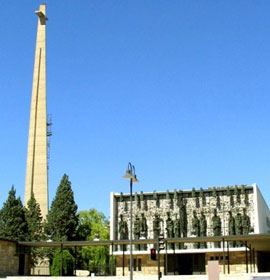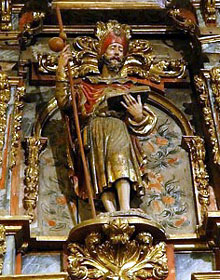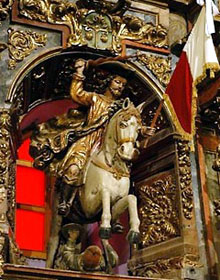Camino de Santiago - French Way - Stage 22 - León to Villadongas del Páramo
Total distance: 21.8 km
The best way to leave Leon is from the cathedral following the scallop shells that pass by the Real Colegiata de San Isidoro and towards the Parador of San Marcos. By the hotel is a bridge over the Rio Bernesga, cross this and walk through the Parque Quevado and then take a left turn at a fork in the road.
There is a crossing here over the railway line via a footbridge, take this and keep going straight passing la Iglesia Capilla de Santiago. The road begins to go uphill from this point. At some traffic lights, about half way up the hill, take a right onto the Camino de la Cruz through some bodegas and an industrial estate. Keep straight on walking past the factories and rejoin the main road that heads into the large village of La Virgen del Camino.
One of the stories attributed to this village comes from the 16th century. It is said that during the festival of the visitation in July 1505, the Virgin Mary appeared to a local shepherd called Alvar Simón Fernández while he was tending his flock. She asked him to go to the city and get the Bishop and bring him to this place to build a shrine in her honour. He asked the Virgin Mary how was the Bishop to know that it was she that sent him. The Virgin Mary seeing that he had a slingshot in his hand asked him to pass it to her. She picked up a small stone and put it into the slingshot. She told the shepherd that wherever this stone landed that is where she wanted her shrine to be built. The shepherd set off to speak to the Bishop in Leon and told him of his vision. He was unconvinced until the shepherd, using his slingshot, hurled a stone which promptly became a boulder when it struck the ground. Now convinced of this miracle the Bishop went away to speak to the other ecclesiastics and people of the village about the apparition and they eventually built an Ermita to the Virgin Mary.

The very modern church that stands in the place where the original Ermita had been is la Iglesia de la Virgen del Camino which was built in 1961 and is managed by a Dominican Order.
Another story attributed to this shrine is that of a merchant being held captive, chained inside a strong box, by the Moors in North Africa in around 1522. The Virgin hearing of his plight and knowing of his desire to visit her shrine transported the merchant, chains and all, to the village of la Virgen del Camino. Inside the sacristy of the new church can be found the merchant's box and chains.
Accommodation in the village can be found either at the municipal albergue across the road from the church or at a couple of hostals and a hotel.
The Camino continues across the road from the church down a minor road towards the cemetery. After about 100 metres you have a choice of routes towards Hospital de Orbigo. Like before we will give you details of both options.
One route, our preferred route, follows the Roman road and is considered the original Camino de Santiago. It does however follow the main road. The other route takes you through the countryside. Both routes are clearly marked. Both routes meet in Hospital de Órbigo.
Our preferred route takes us to the village of Villadangos del Páramo which will be our stop on this section.
Head up the hill, passing the cemetery on your left, to rejoin the main road. Unfortunately this is the main Madrid to Astorga road so be careful as you walk along the hard shoulder. After about 3 kilometres you come to the small village of Valverde de la Virgen where there is a private hostal and a café that does food. Walk through the village and in about 1 kilometre you come to the small village of San Miguel del Camino where a local man leaves sweets, nuts and other such treats for the passing pilgrim.
Just after coming through San Miguel del Camino fork left off the road onto a path that runs parallel to it and follow the track over open land running more or less parallel to the road. At some point it will look like you are about to rejoin the road, don't, keep walking straight until after about 5 kilometres you come to the Urbanización de Santiago where you will find 2 hostals. 1.5 kilometres further on you come to the end of this particular stage of the Camino de Santiago, the village of Villadangos del Páramo.


In Villadangos del Páramo it is worth visiting the at the entrance of the church depicting the legendary battle at Clavijo in 844 between Ramiro I de Asturias and Abderramán II, the Emir of Córdoba. It is at this battle that Santiago in his guise as Santiago Matamoros is reputed to have helped the vastly outnumbered Christian army. Inside the church are some impressive statues of Santiago both as Santiago Peregrino and as Santiago Matamoros.
The village's other claim to fame is that it was here that the battle between the armies of Alfonso I of Aragon and Queen Urraca of Leon took place. Now this is a tale of marital strife gone a little crazy, yes the two monarchs were married to each other at the time. The marriage between the two had originally started out as a plan to unify the two powerful kingdoms, unfortunately it led to years of civil war. Eventually they had their marriage annulled and the wars ceased.
Accommodation here can be found at the municipal albergue at the entrance to the village or at the hostal.
The alternative route is slightly longer and only has one village between La Virgen del Camino and Hospital de Orbigo. It is however, a lot quieter and takes you along minor country roads and farm tracks. Be aware that at times there are not many way markers.
At La Virgen del Camino take a left turn off the main road and walk uphill past a wall. After a short while you will join a minor road, follow this road for 2 kilometres until you reach Fresno del Camino where there is a fountain and a café.
Leaving Fresno del Camino keep walking uphill and after about 2 kilometres the road descends into the village of Oncina de la Valdoncina. There are no services here other than a fountain where you can replenish your water supply.
At the end of the village veer right then left taking a track at a sign that says Chozas de Abajo 5km. Up here the area is as flat as a pancake, continue more or less forward until you reach Chozas de Abajo where you can get a meal at the bar as well as pitch your tent, if you have one, at the camping site.
Walk down the Calle Real, which is signposted Villar de Mazarife 4km, taking a left turn, then a right, crossing a bridge which brings you to another track which leads you to Villar de Mazarife.
Villar de Mazarife is the largest village on this section and has accommodation in the form of 3 private albergues. Two of them provide an evening meal and breakfast, the other has a vending machine and a kitchen where you can prepare your own food. Also in the village are a couple of cafés and a bakery as well as a supermarket.
Walk through the village to Plaza Mediovilla and down Calle Camino to the main road, the Carretera Valcalbo. Cross the road where you see a signpost saying Villavente 9.3km and walk down a minor road continuing straight on for about 6 kilometres before crossing a bridge over the canal. A further 2 kilometres down the line you come to a bridge over a large canal cross it and follow the road into Villavante.
Villavante doesn't have any accommodation but it does have a couple of bars who unfortunately don't provide food but there is a small shop. Walk out of the village passing the church, forking left before crossing the railway line where you will see a notice saying Hospital de Orbigo 3.5km. When you reach the AP71 motorway cross it using the footbridge and follow the arrows showing the Camino route for bicycles, it's pretty straightforward, soon after you will reach the bridge of Hospital de Orbigo where the two routes merge.

